30.01.2007
Corus-Tournament in Wijk aan Zee: a Creative Survey (Rounds 3-4)
Round 3
A.Shirov (2715) – T.Radjabov (2729) [E97]
1.d4 ¤f6 2.c4 g6 3.¤c3 Ґg7 4.e4 d6 5.Ґe2 0–0 6.¤f3 e5 7.0–0 ¤c6 8.d5 ¤e7 9.b4 ¤h5 10.¦e1 f5 11.¤g5 ¤f6 12.f3 ўh8 13.¤e6 Ґxe6 14.dxe6 ¤h5 15.g3 Ґf6 16.c5 f4

17.ўg2. Teimour Radjabov didn't have to wait long for the repetition of the line from the 1st round. Alexey Shirov applies a natural and obvious novelty (just a reminder that Loek Van Wely played 17.g4?).
17...¤c6! 17...a5, suggested firstly by computer programs looks less logical.
18.cxd6 cxd6 19.¤d5 ¤d4. Another option is 19...¤g7 20.e7 Ґxe7 21.gxf4 ¤e6 with a good play.
20.Ґb2 ¤xe6 21.g4 ¤hg7 22.¤xf6 ¦xf6. The knights are placed outwardly clumsy but actually they are not that bad as the position is rather closed.
23.Јd5 Јe7 24.¦ed1 ¦d8 25.Јa5?! A strange sideways move, it was more logical to complete the mobilization by 25.¦ac1.
25...b6. The b6 is weakened but in return Black wins a tempo which is of a greater importance. 25...h5 is clearly premature in view of the simple 26.gxh5 b6 27.Јd5 gxh5 28.ўh1, and it is White who will soon begin to play on the g-file.
26.Јd5 ¦ff8. Teimour Radjabov is preparing h7-h5.
27.¦ac1. Rather passive is 27.Ґc3in order to meet 27...h5 with 28.h3 when the bishop is ready to block the way for the black queen to g3 via h4. Black's chances are at least not worse for example he has the following possibility: 28...¦c8 29.¦ac1 ¦xc3 30.¦xc3 Јh4 with counterplay sufficient for equality.
27...h5 28.gxh5
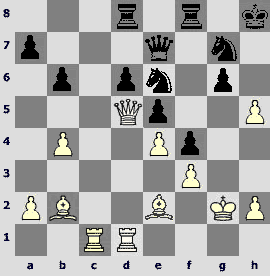
28...Јh4! Black can't do without this move, bad is 28...¤xh5 29.¦c6!
29.¦c6. Alexey is conducting his play without reckoning with Teimour's counterplay. It was time to go for prophylaxis on the kingside: 29.h6!? Јxh6 30.¦g1 followed by ўh1. The immediate 29.¦g1 is possible as well with the same idea to take the king away to h1.
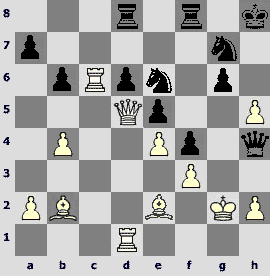
29...g5! Even in such positions where the number of lines is beyond human calculation there exist strategical concepts which help to find the way in the whirlpool of complications. Teimour understands that without extracting the f3 "molar" his attack is doomed to reach the deadlock. This is proved by the simple line 29...¤g5 30.h6! Јxh6 (30...Јh3+ 31.ўg1 Јxh6 32.¦xd6) 31.h4! ¤f7 32.¦c7.
30.¦xd6? Here the same comment may be given as on the previous White's move with the difference that this capture already loses. Now prophylaxis was of vital importance – 30.ўh1 g4 31.¦g1; another prophylactic possibility lay in the luring away the black queen by 30.h6!? Јxh6 31.h3 Јh4 32.¦h1. In both cases White has counterplay.
30...g4! The black pawns supported by the knights and the queen wipe everything off their way.
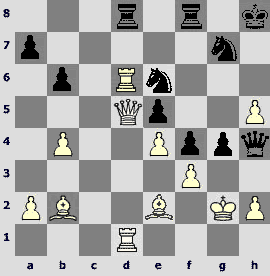
31.¦xe6. Also bad is 31.Јxe5 Јh3+ 32.ўg1 ¦xd6 33.Јxd6 g3.
31...¦xd5 32.¦h6+ ўg8 33.Ґc4. It is nice of course but the queen is senior.

33...gxf3+ 34.ўh1 ¤xh5 35.¦g1+
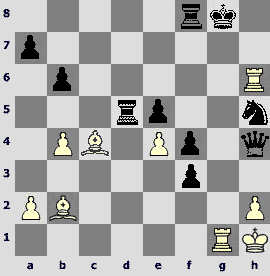
35...¤g3+! 36.¦xg3+ fxg3 37.¦xh4 g2+ 38.ўg1 f2+ 39.ўxg2 f1Ј+ 40.Ґxf1 ¦d2+ 41.ўg3 ¦xb2 42.Ґc4+ ўg7 43.Ґb3 ¦b1 44.ўg2 ¦c8 45.ўf3 ¦c3+ 46.ўg4 ¦f1 47.ўh5 ўf6 0–1
Very beautiful and interesting game.
S.Tiviakov (2667) – V.Kramnik (2766) [C43]
In this game nothing interesting happened. Both opponents obviously didn't mind drawing as they went for a well-known drawish opening line.
1.e4 e5 2.¤f3 ¤f6 3.d4 ¤xe4 4.Ґd3 d5 5.¤xe5 ¤d7 6.¤xd7 Ґxd7 7.0–0 Ґd6 8.c4 c6 9.cxd5 cxd5 10.¤c3 ¤xc3 11.bxc3 0–0 12.Јh5 g6 13.Јxd5 Јc7 14.Јf3 Јxc3 15.Ґh6 ¦fe8 16.Јf6 Ґf8 17.Ґxf8 ¦xf8 18.Ґe4 Ґc6 19.¦ac1 Јb4 20.Ґxc6 bxc6 21.¦xc6 ¦ad8 22.¦a6 Јxd4 23.Јxd4 ¦xd4 24.¦xa7 ¦c8 25.g3 ¦c2 26.ўg2 ¦dd2 27.a3 ¦a2 28.h4 ¦d3 Ѕ–Ѕ
D.Navara (2719) – P.Svidler (2728) [A16]
1.¤f3 ¤f6 2.c4 g6 3.¤c3 d5 4.Јa4+ Ґd7 5.Јb3 dxc4 6.Јxc4 a6 7.d4 b5 8.Јb3 ¤c6 9.Ґg5 Ґe6 10.Јd1 Ґg7 11.e3 0–0 12.Ґe2 ¤d5 13.¤e4 h6 14.Ґh4 f5 15.¤c5 Јd6 16.0–0 Ґf7 17.¤b7 Јd7

18.Ґg3. Here the repetition might occur –18.¤c5 Јd6 19.¤b7 but it didn't come to pass.
18...g5 19.a4. To push the queen to the back rank by 19.¤c5 is tempting. Perhaps it was stronger.
19...f4 20.exf4 gxf4 21.Ґh4 ¤db4 22.axb5 axb5 23.¦xa8 ¦xa8 24.Ґxb5 Јd5 25.Ґe2 ¦b8 26.¤c5 ¤xd4 27.¤xd4 Јxc5 Ѕ–Ѕ
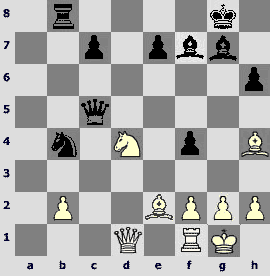
The draw agreement should be considered premature. Black's pawns are scattered over the board and his king is weak but his pieces are more active and he is able to gain the b2 pawn. Had the opponents continue to play it would be unclear what it all would end up in. Probably 28.¤f3 would have followed and now Black has a choice – either to capture the pawn 28...Ґxb2 when White has compensation or to choose 18...e5!, when Black's chances are objectively better for instance 29.¤d2 Јc2!, transposing into a better ending.
V.Anand (2779) – L.Aronian (2744) [C89]
1.e4 e5 2.¤f3 ¤c6 3.Ґb5 a6 4.Ґa4 ¤f6 5.0–0 Ґe7 6.¦e1 b5 7.Ґb3 0–0 8.c3 d5 9.exd5 ¤xd5 10.¤xe5 ¤xe5 11.¦xe5 c6 12.d4 Ґd6 13.¦e1 Јh4 14.g3 Јh3 15.¦e4 g5 16.Јf1 Јh5 17.¤d2 Ґf5 18.f3 ¤f6
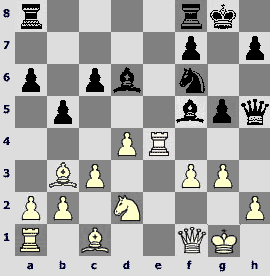
19.Јg2! A good novelty from Vishy Anand.
19...Јg6 20.¦e3 ¦ae8 21.¤e4 ¤xe4
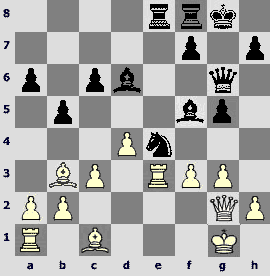
22.g4! That's the move in which the main idea of White's novelty consists.
22...¤g3 23.hxg3 Ґb1 24.Јe2 ¦xe3 25.Јxe3 h6 26.Јe1 Ґc2. 26...Ґd3!? came seriously into consideration. Black's idea is to play ўg8-g7 and f7-f5, launching an attack.
27.Ґxc2 Јxc2 28.Јe4 Јd1+ 29.ўg2 ўg7
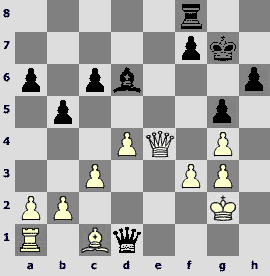
30.Јe3?! 30.¦b1 ¦e8 31.Ґf4 Јa4 32.Јxe8 Јc2+ 33.Ґd2 Јxb1 leadstoadraw. 30.b3! with the same idea 31.¦b1 ¦e8 32.Ґf4 would pose Black difficult problems as his queen has no a4 square to retreat.
30...Ґxg3 31.ўxg3 ¦e8 32.Јxe8 Ѕ–Ѕ
S.Karjakin (2678) – V.Topalov (2783) [B90]
1.e4 c5 2.¤f3 d6 3.d4 cxd4 4.¤xd4 ¤f6 5.¤c3 a6 6.Ґe3 e5 7.¤b3 Ґe6 8.f3 h5. I may humbly note that I was the first to come up with this move and to apply it in the game against Peter Svidler back in the distant 1995. To be objective its main merit is that it's less explored. There are no many long forced lines here.
9.Јd2 ¤bd7 10.0–0–0 Ґe7 11.ўb1 Јc7 12.h3 b5 13.Ґd3 h4 14.f4 ¦c8 15.¦he1 g6 16.Јf2 Јb7 17.¤a5

17...Јb8? The thirst for victory may play a malicious joke sometimes. 17...Јc7 18.¤b3 led to repetition.
18.f5 gxf5 19.exf5 Ґc4 20.¤xc4 bxc4 21.Ґe4 ¤xe4 22.¤xe4 ¤f6 23.Јf3. Black's forces are separated, his bishop is bad, his pawns are weak. White's advantage is huge, probably decisive.
23...Јc7 24.¤c3 ¦g8 25.Ґf2 ¦h8 26.¤d5 ¤xd5 27.¦xd5 f6 28.¦e4 ¦b8 29.¦xh4 ¦xh4 30.Ґxh4 Јb7 31.b3 ўd7 32.Ґe1 Јc6 33.h4 ¦c8 34.Јd1 ¦g8 35.g3 Ґf8 36.Ґf2 Ґh6 37.Ґc5 Ґf8 38.Ґf2 Ґh6 39.¦c5 Јg2 40.Ґe1 cxb3 41.axb3 Ґd2
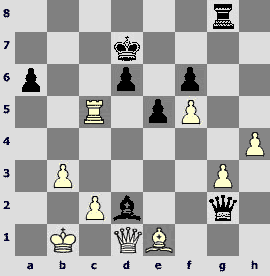
42.¦c4. Surely to discover 42.Јh5! and all the following lines wasn't easy – 42...¦e8 (42...dxc5 43.Јf7+ ўd6 44.Јxg8 Ґxe1 45.Јd8+ ўc6 46.Јa8+) 43.Јf7+ ¦e7 44.¦c7+ ўxc7 45.Јxe7+ ўc6 46.Јe8+! ўc7 47.Јf7+ ўc6 48.Јc4+! The important queen's transference with checks. Black retains practical chances to save the game but the queen ending should be won for White.
42...d5 43.¦a4 Ґxe1 44.Јxe1 ¦xg3 45.¦xa6 Јg1 46.Јxg1 ¦xg1+ 47.ўb2 ўe7?! After the natural 47...¦h1 48.¦xf6 ¦xh4 49.¦e6 e4 Black should hold.
48.¦e6+ ўf7 49.¦d6 e4?! 49...d4 suggested itself, when after 50.b4 ¦f1 51.b5 (it seems that in the line 51.¦d7+ ўe8 52.¦d5 ¦xf5 53.b5 ¦h5 54.b6 ўf7 55.¦b5 ¦h8 Black is saved) 51...¦xf5 52.b6 e4 53.¦xd4 ¦b5+ 54.ўc3 ¦xb6 55.¦xe4 White retains the winning chances.
50.ўc3 ¦f1 51.¦d7+ ўf8
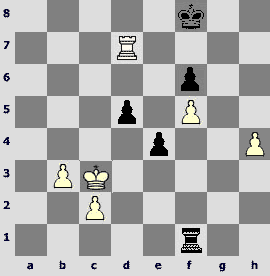
52.¦d8+? Nerves, weariness... After both 52.h5 ¦xf5 53.h6 ўg8 54.b4, and the immediate 52.b4 White is close to a win.
52...ўf7 53.¦d7+ ўf8 54.¦d8+ Ѕ–Ѕ
R.Ponomariov (2723) – M.Carlsen (2690) [D10]
1.d4 d5 2.c4 c6 3.¤c3 ¤f6 4.e3 a6 5.¤f3
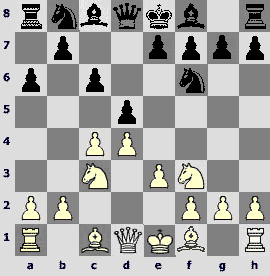
5...Ґf5?! It is not accidental that normally Black doesn't play this.
6.¤e5. 6.Јb3 creates problems as well but the text is even stronger.
6...h6. Forced as bad is 6...e6 on account of the standard 7.g4 Ґe4 8.f3 Ґg6 9.h4.
7.Јb3 ¦a7 8.cxd5 cxd5 9.Ґd2 e6 10.¦c1 ¤bd7 11.Ґb5 Ґd6 12.¤xd7 ¤xd7 13.Ґxd7+
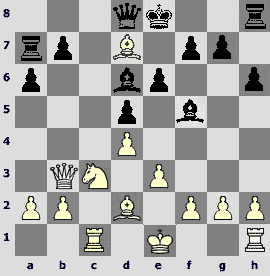
13...Јxd7?! The sudden 13...ўxd7! 14.¤a4 b5 15.¤c5+ ўe7 would allоw to continue fighting.
14.¤a4 0–0 15.¤b6 Јd8 16.¤c8. The rest is simple.
16...Јxc8 17.¦xc8 ¦xc8 18.Јb6 Ґb8 19.0–0 ўh7 20.¦c1 Ґc2 21.Ґa5 ўg6 22.Јb4 ¦c4 23.Јd2 Ґf5 24.¦xc4 dxc4 25.Ґb6 ¦a8 26.Јe2 e5 27.Јxc4 exd4 28.Јxd4 f6 29.f4 Ґb1 30.Јd5 1–0
L.Van Wely (2683) – A.Moltylev (2647) [A29]
1.c4 e5 2.g3 ¤f6 3.Ґg2 d5 4.cxd5 ¤xd5 5.¤c3 ¤b6 6.¤f3 ¤c6 7.0–0 Ґe7 8.a3 Ґe6 9.d3 f5 10.b4 Ґf6
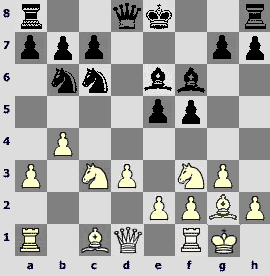
11.e4! The topical move for the English Opening.
11...0–0 12.exf5 Ґxf5 13.¤e4 ўh8 14.b5

14...Ґxe4!? A committal decision. 15.dxe4 ¤d4 16.¤xd4 exd4
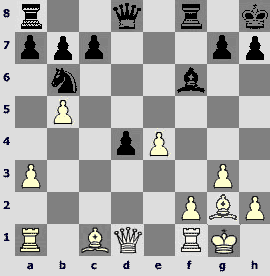
17.e5. It is essential to clear the path for the bishop g2.
17...Ґxe5 18.Ґxb7 ¦b8 19.Ґe4 ¤d5 20.Јd3. The queen is considered to be a bad blocker but this is not the case.
20...g6 21.Ґh6 ¦e8 22.¦fe1 Јd6 23.Јc4 ¤c3 24.Ґc6 ¦ed8

25.ўg2? Missing an advantage. White could retreat 25.Јd3, while even stronger was the vigorous 25.f4!, invading through the e-file with a great effect.
25...d3! 26.Ґf4 ¤e2 27.Ґe3 Ґd4 28.Јxd3 Ґxa1 29.Јxd6 ¦xd6 30.¦xe2 a6 31.Ґf4 axb5 32.Ґxd6 cxd6 33.¦d2 ¦b6 34.¦xd6 Ґb2 35.a4 bxa4 36.¦d8+ ўg7 37.¦d7+ ўh8 38.Ґxa4 ¦b4 39.Ґc6 Ґd4 40.h4 Ґc5 41.¦f7 ¦d4 42.ўh3 ўg8 43.¦c7 ¦d6 44.Ґb5 Ґxf2 45.Ґc4+ ўh8 46.¦c8+ ўg7 47.¦c7+ ўh8 48.¦c8+ ўg7 49.¦g8+ ўh6 50.g4 Ґe3 51.g5+ Ґxg5 52.hxg5+ ўxg5 53.¦g7 ¦c6 Ѕ–Ѕ
Round4
V.Kramnik (2766) – D.Navara (2719) [A30]
A very subtle ending. Vladimir was examining and examining his young opponent but couldn't carry the exam through. Black's stubborn defence was rewarded by half a point.
1.¤f3 ¤f6 2.c4 c5 3.g3 ¤c6 4.¤c3 d5 5.d4 cxd4 6.¤xd4 dxc4 7.¤xc6 Јxd1+ 8.¤xd1 bxc6 9.Ґg2 ¤d5 10.¤e3 e6 11.¤xc4 Ґa6
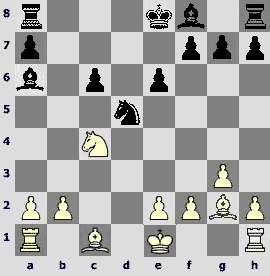
12.¤a5 ¦c8 13.Ґd2 Ґe7 14.¦c1 c5 15.b3 0–0 16.0–0 ¦fd8 17.Ґf3 ўf8 18.¦fd1 ўe8 19.Ґe1 ¦d7 20.e3 Ґf6 21.¤c4 ўe7 22.Ґa5 Ґb5 23.Ґe2 ¤b4
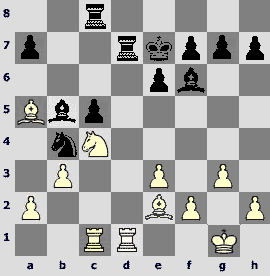
24.¤d6! ¦xd6 25.Ґxb5 ¤xa2 26.¦xd6 ¤xc1 27.¦d7+ ўf8 28.¦xa7 Ґd8. 28...¦b8 29.Ґc4 ¤xb3 30.Ґc7 ¦b4 31.Ґd6+ ўe8 32.Ґa6 or 32.Ґe2 doesn't solve all Black's problems either as the white bishops cause Black many troubles.
29.Ґc4 ¦b8
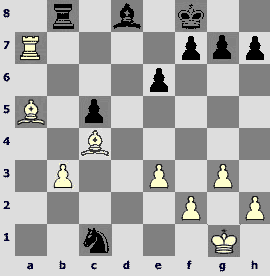
30.Ґxd8. Stronger was to keep the bishops and to play being a pawn down for some time: 30.Ґc3 ¤xb3 31.Ґe5! (to 31.¦a3 Black has the saving 31...Ґf6 32.Ґxf6 ¤d2!) 31...¦b4 32.Ґd3. The fight may continue approximately this way: 32...Ґf6 (32...g6 is quite bad as it leaves the e5 square for the white bishop for ever) 33.Ґd6+ ўe8 34.Ґxh7 ¦b6 35.Ґc7 ¦b4 36.Ґg8 Ґe7 37.Ґe5 f6 38.Ґc3, and White has a big advantage.
30...¦xd8 31.¦a1 ¦d1+ 32.ўg2 g5 33.ўf3 h5 34.h3 ўe7 35.¦a5 f5 36.¦xc5 g4+ 37.hxg4 hxg4+ 38.ўf4 ўf6 39.e4 ¦d4 40.ўe3 ¦xe4+ 41.ўd2 ¤a2 42.¦b5 f4 43.¦a5 ¤b4 44.¦a4 fxg3 45.fxg3 ¤c6 46.Ґb5 ¤b4 47.Ґc4 ¤c6 48.Ґb5 ¤b4
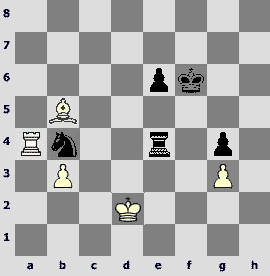
49.Ґc6 ¦d4+ 50.ўc3 ¦d6 51.¦xb4 ¦xc6+ 52.¦c4 ¦d6 53.b4 e5 54.b5 ўf5 55.¦b4 e4 56.¦d4 ¦h6 57.¦d1 e3 58.ўd3

58...e2! 59.¦b1 ¦h2 60.ўd4 ¦f2 61.¦e1 ¦g2 62.b6 ¦xg3 63.¦xe2 Ѕ–Ѕ
M.Carlsen (2690) – V.Anand (2779) [B90]
1.e4 c5 2.¤f3 d6 3.d4 cxd4 4.¤xd4 ¤f6 5.¤c3 a6 6.Ґe3 e5 7.¤f3 Ґe7 8.Ґc4 0–0 9.0–0 Ґe6 10.Ґb3 ¤c6 11.Ґg5 ¤d7 12.Ґxe7 Јxe7 13.¤d5 Јd8 14.c3 ¤a5 15.Ґc2 ¤c4 16.b3 ¤a3 17.¤e3 ¤xc2 18.Јxc2 ¦c8 19.¦fd1 ¦c6 20.¦ac1 b5 Ѕ–Ѕ

The position is roughly equal (to my mind Black is a bit more pleasant). Vishy Anand decided not to check up his young opponent's technique. I think continuing the game he would have chances to outplay the junior who had lost two games prior to this one and therefore wasn't in the best mood.
A.Motylev (2647) – L.Aronian (2744) [C87]
1.e4 e5 2.¤f3 ¤c6 3.Ґb5 a6 4.Ґa4 ¤f6 5.0–0 Ґe7 6.¦e1 d6. This line doesn't enjoy a fine reputation.
7.Ґxc6+ bxc6 8.d4 exd4 9.¤xd4 Ґd7 10.¤c3 0–0 11.Ґf4 g6 12.h3 ¤h5 13.Ґh2 ¤g7 14.Јd3 Јb8 15.b3 Јb4 16.a3 Јb7 17.¦ad1 ¦fe8 18.Ґf4 Ґf8 19.Ґh6 ¦e5 20.Ґf4 ¦ee8 21.Ґh6 ¦e5 22.Ґf4 Ѕ–Ѕ

Sasha Motylev wasn't obliged to repeat the moves. White stands better.
P.Svidler (2728) – R.Ponomariov (2723) [B90]
In response to a rare plan with f2-f4 (f2-f3 followed by g2-g4 is more frequently played) Ruslan Ponomariov chose a more logical arrangement than Denis Khismatullin against Peter Svidler at the recent Russian Championship. Ruslan didn't move the queen to c7 on move 9 as it is placed there inferior than on d8. Such is the distinctive feature of this line.
1.e4 c5 2.¤f3 d6 3.d4 cxd4 4.¤xd4 ¤f6 5.¤c3 a6 6.Ґe3 e5 7.¤b3 Ґe6 8.Јd2 ¤bd7 9.f4 b5 10.0–0–0 Ґe7 11.h3 ¦c8 12.Ґd3 exf4 13.Ґxf4 ¤e5 14.ўb1 0–0 15.g4?! [the straight 15.¤d4 more logical] 15...¤fd7 16.¤d4 ¤b6 17.¦he1 Ґf6 18.g5 ¤ec4 19.Ґxc4 ¤xc4 20.Јc1 Ґxd4 21.¦xd4 Јb6

A slight initiative is on Black's side but Peter managed to hold.
22.¦d3 ¦fe8 23.Ґe3 Јa5 24.¤d5 Ґxd5 25.exd5 ¦e5 26.Ґf2 b4 27.¦xe5 ¤xe5 28.¦d4 Јb5 29.Јd1 a5 30.b3 ¦c3 Ѕ–Ѕ
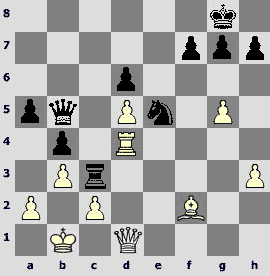
It should be noticed that the resources of fight are not completely exhausted yet. Had I been Black I would play some more.
L.Van Wely (2683) – S.Karjakin (2678) [E20]
1.d4 ¤f6 2.c4 e6 3.¤c3 Ґb4 4.¤f3 c5 5.g3 cxd4 6.¤xd4 0–0 7.Ґg2 d5 8.cxd5 ¤xd5 9.Јb3 ¤c6 10.¤xc6 bxc6 11.0–0 Јa5 12.Ґd2 Ґxc3 13.bxc3 Ґa6 14.¦fd1 Јc5 15.e4 Ґc4 16.Јa4 ¤b6 17.Јb4 Јh5 18.Ґf4 c5 19.Јa5 ¦fc8 20.h3 f6 21.Ґe3 e5 22.Ґxc5

22...Ґe6. 22...Ґe2! followed by ¤b6-c4 would solve all the problems.
23.Ґxb6 axb6 24.Јxb6 Ґxh3 25.Ґxh3 Јxh3
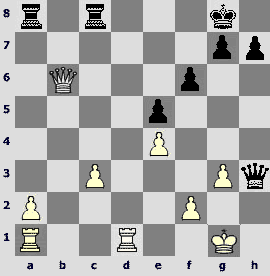
The a-passer is strong and objectively Black's position is very dangerous but Serezha is right in time to save the game.
26.Јb7 h5 27.¦d3 ¦ab8 28.Јd5+ ўh7 29.a4 ¦b2 30.a5 h4 31.a6 ¦cb8 32.¦ad1 ¦xf2 33.ўxf2 Јh2+ 34.ўf3 Јxg3+ 35.ўe2 Јg2+ 36.ўe1 Јg1+ 37.ўe2 Ѕ–Ѕ
V.Topalov (2783) – A.Shirov (2715) [D89]
An opening catastrophe for Alexey Shirov. He just wasn't ready (or may be didn't review the lengthy forced lines the day before and couldn't recall it during the game?). Nominally Veselin's 25th move is a novelty though this move was mentioned in the annotations to a game that had already been played before and it is also suggested by a computer program. To solve the arising problems over the board was impossible.
1.d4 ¤f6 2.c4 g6 3.¤c3 d5 4.cxd5 ¤xd5 5.e4 ¤xc3 6.bxc3 Ґg7 7.Ґc4 c5 8.¤e2 ¤c6 9.Ґe3 0–0 10.0–0 Ґg4 11.f3 ¤a5 12.Ґd3 cxd4 13.cxd4 Ґe6 14.d5 Ґxa1 15.Јxa1 f6 16.Јd4 Ґf7 17.Ґh6 ¦e8 18.Ґb5 e5 19.Јf2 ¦e7 20.f4 exf4 21.Јxf4 Јb6+ 22.ўh1 Ґxd5 23.exd5 Јxb5 24.Јxf6 Јe8

25.Јd4! ¦d8 26.h3! ¦f7 27.¦xf7 Јxf7 28.Јc3 b6 29.¤g3 ¤b7 30.¤e4 Јe7 31.¤f6+ ўf7 32.¤xh7 ўg8 33.¤f6+ ўf7 34.¤g4 ўg8 35.Јd2 ¦e8 36.Јf4 Јd6 37.Јf2 Јc5 38.Јg3 Јd4 39.ўh2 ¤d8 40.Јd6 ¤e6 41.Ґe3 1–0
T.Radjabov (2729) – S.Tiviakov (2667) [B35]
A slow maneuvering play during 70 moves... Teimour has showed that he is able to not only carry out attacks.
1.e4 c5 2.¤f3 ¤c6 3.d4 cxd4 4.¤xd4 g6 5.¤c3 Ґg7 6.Ґe3 ¤f6 7.Ґc4 0–0 8.Ґb3 a5 9.0–0 ¤xd4 10.Ґxd4 d6 11.Јe2 Ґd7 12.¦ad1 a4 13.Ґc4 Ґc6 14.a3 ¦a5 15.¤d5 ¤d7 16.¦fe1 ¦e8 17.c3 e6 18.¤b4 Ґf8 19.f3 Јc7 20.Јf2 ¤c5 21.¦d2 Јe7 22.¦de2 ¦c8 23.Ґa2 Ґb5 24.¦d2 ¤d7 25.f4 Ґc4 26.Ґb1 ¤c5 27.Ґc2 ¤b3 28.Ґxb3 Ґxb3 29.¦d3 Ґc4 30.¦h3 e5 31.Ґb6 ¦b5 32.f5 f6 33.Ґe3 gxf5 34.Јxf5 Ґe6 35.¦g3+ ўh8 36.Јf2 Ґg7 37.Јd2 ¦g8 38.¦d1 Ґf8 39.¦xg8+ ўxg8 40.Ґh6 Ґb3 41.¦f1 ¦c5 42.¦f3 ¦c8 43.¤d5 Ґxd5 44.Јxd5+ ўh8 45.Ґe3 Ґg7 46.Јb5 ¦a8 47.Ґf2 Јc7 48.¦d3 Ґf8 49.¦d5 Јc6 50.Јd3 Ґe7 51.¦b5 Ґd8 52.¦d5 Ґc7 53.h3 ¦f8 54.¦b5 ¦a8 55.¦d5 ¦g8 56.ўh2 ¦g6 57.c4 ¦g8 58.Ґh4 ¦g6 59.Јf3 ўg7
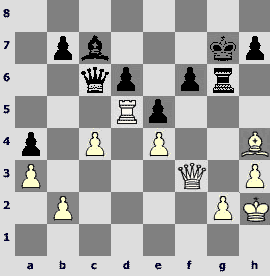
60.c5!? dxc5 61.Јf5 Ґd6? 61...Ґa5 orи 61...Ґb6 would allow to defend.
62.Јe6 f5 63.Јxf5. This position is difficult in spite of the absence of direct threats. Most likely it is lost for Black.
63...Јc7 64.Ґg3. I wouldn't like to give the rook the f6 square moreover White barely wants to take the e5 pawn. After the bishop exchange Black's drawing chances will increase. The rook transference to f3 after 64.¦d3 seemed interesting to me.
64...¦f6 65.Јh5 ¦e6 66.Јe2 ўf8 67.Јd1
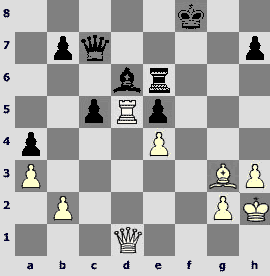
67...b5? 67...Јc6 allowed to carry the resistance on.
68.Јf1+ ўe8 69.Јxb5+ Јd7 70.Јe2 Јf7 71.Јa6 Јd7 72.Јa8+ ўf7 73.Јh8 h6 74.Јh7+ ўe8 75.Јg8+ 1–0
